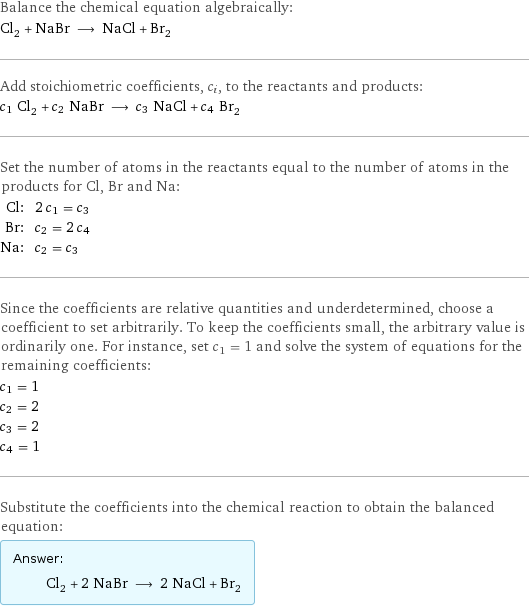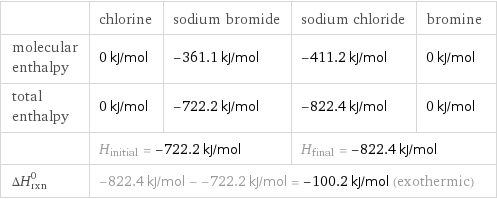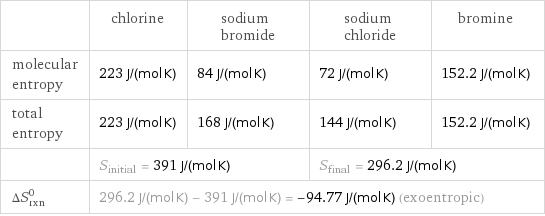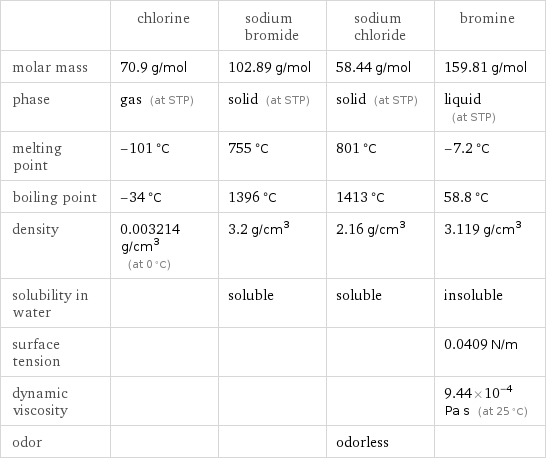Input interpretation

Cl_2 (chlorine) + NaBr (sodium bromide) ⟶ NaCl (sodium chloride) + Br_2 (bromine)
Balanced equation

Balance the chemical equation algebraically: Cl_2 + NaBr ⟶ NaCl + Br_2 Add stoichiometric coefficients, c_i, to the reactants and products: c_1 Cl_2 + c_2 NaBr ⟶ c_3 NaCl + c_4 Br_2 Set the number of atoms in the reactants equal to the number of atoms in the products for Cl, Br and Na: Cl: | 2 c_1 = c_3 Br: | c_2 = 2 c_4 Na: | c_2 = c_3 Since the coefficients are relative quantities and underdetermined, choose a coefficient to set arbitrarily. To keep the coefficients small, the arbitrary value is ordinarily one. For instance, set c_1 = 1 and solve the system of equations for the remaining coefficients: c_1 = 1 c_2 = 2 c_3 = 2 c_4 = 1 Substitute the coefficients into the chemical reaction to obtain the balanced equation: Answer: | | Cl_2 + 2 NaBr ⟶ 2 NaCl + Br_2
Structures

+ ⟶ +
Names

chlorine + sodium bromide ⟶ sodium chloride + bromine
Reaction thermodynamics
Enthalpy

| chlorine | sodium bromide | sodium chloride | bromine molecular enthalpy | 0 kJ/mol | -361.1 kJ/mol | -411.2 kJ/mol | 0 kJ/mol total enthalpy | 0 kJ/mol | -722.2 kJ/mol | -822.4 kJ/mol | 0 kJ/mol | H_initial = -722.2 kJ/mol | | H_final = -822.4 kJ/mol | ΔH_rxn^0 | -822.4 kJ/mol - -722.2 kJ/mol = -100.2 kJ/mol (exothermic) | | |
Gibbs free energy

| chlorine | sodium bromide | sodium chloride | bromine molecular free energy | 0 kJ/mol | -349 kJ/mol | -384.1 kJ/mol | 0 kJ/mol total free energy | 0 kJ/mol | -698 kJ/mol | -768.2 kJ/mol | 0 kJ/mol | G_initial = -698 kJ/mol | | G_final = -768.2 kJ/mol | ΔG_rxn^0 | -768.2 kJ/mol - -698 kJ/mol = -70.2 kJ/mol (exergonic) | | |
Entropy

| chlorine | sodium bromide | sodium chloride | bromine molecular entropy | 223 J/(mol K) | 84 J/(mol K) | 72 J/(mol K) | 152.2 J/(mol K) total entropy | 223 J/(mol K) | 168 J/(mol K) | 144 J/(mol K) | 152.2 J/(mol K) | S_initial = 391 J/(mol K) | | S_final = 296.2 J/(mol K) | ΔS_rxn^0 | 296.2 J/(mol K) - 391 J/(mol K) = -94.77 J/(mol K) (exoentropic) | | |
Equilibrium constant
![Construct the equilibrium constant, K, expression for: Cl_2 + NaBr ⟶ NaCl + Br_2 Plan: • Balance the chemical equation. • Determine the stoichiometric numbers. • Assemble the activity expression for each chemical species. • Use the activity expressions to build the equilibrium constant expression. Write the balanced chemical equation: Cl_2 + 2 NaBr ⟶ 2 NaCl + Br_2 Assign stoichiometric numbers, ν_i, using the stoichiometric coefficients, c_i, from the balanced chemical equation in the following manner: ν_i = -c_i for reactants and ν_i = c_i for products: chemical species | c_i | ν_i Cl_2 | 1 | -1 NaBr | 2 | -2 NaCl | 2 | 2 Br_2 | 1 | 1 Assemble the activity expressions accounting for the state of matter and ν_i: chemical species | c_i | ν_i | activity expression Cl_2 | 1 | -1 | ([Cl2])^(-1) NaBr | 2 | -2 | ([NaBr])^(-2) NaCl | 2 | 2 | ([NaCl])^2 Br_2 | 1 | 1 | [Br2] The equilibrium constant symbol in the concentration basis is: K_c Mulitply the activity expressions to arrive at the K_c expression: Answer: | | K_c = ([Cl2])^(-1) ([NaBr])^(-2) ([NaCl])^2 [Br2] = (([NaCl])^2 [Br2])/([Cl2] ([NaBr])^2)](../image_source/009729474b4759d8d9b7842953573f1d.png)
Construct the equilibrium constant, K, expression for: Cl_2 + NaBr ⟶ NaCl + Br_2 Plan: • Balance the chemical equation. • Determine the stoichiometric numbers. • Assemble the activity expression for each chemical species. • Use the activity expressions to build the equilibrium constant expression. Write the balanced chemical equation: Cl_2 + 2 NaBr ⟶ 2 NaCl + Br_2 Assign stoichiometric numbers, ν_i, using the stoichiometric coefficients, c_i, from the balanced chemical equation in the following manner: ν_i = -c_i for reactants and ν_i = c_i for products: chemical species | c_i | ν_i Cl_2 | 1 | -1 NaBr | 2 | -2 NaCl | 2 | 2 Br_2 | 1 | 1 Assemble the activity expressions accounting for the state of matter and ν_i: chemical species | c_i | ν_i | activity expression Cl_2 | 1 | -1 | ([Cl2])^(-1) NaBr | 2 | -2 | ([NaBr])^(-2) NaCl | 2 | 2 | ([NaCl])^2 Br_2 | 1 | 1 | [Br2] The equilibrium constant symbol in the concentration basis is: K_c Mulitply the activity expressions to arrive at the K_c expression: Answer: | | K_c = ([Cl2])^(-1) ([NaBr])^(-2) ([NaCl])^2 [Br2] = (([NaCl])^2 [Br2])/([Cl2] ([NaBr])^2)
Rate of reaction
![Construct the rate of reaction expression for: Cl_2 + NaBr ⟶ NaCl + Br_2 Plan: • Balance the chemical equation. • Determine the stoichiometric numbers. • Assemble the rate term for each chemical species. • Write the rate of reaction expression. Write the balanced chemical equation: Cl_2 + 2 NaBr ⟶ 2 NaCl + Br_2 Assign stoichiometric numbers, ν_i, using the stoichiometric coefficients, c_i, from the balanced chemical equation in the following manner: ν_i = -c_i for reactants and ν_i = c_i for products: chemical species | c_i | ν_i Cl_2 | 1 | -1 NaBr | 2 | -2 NaCl | 2 | 2 Br_2 | 1 | 1 The rate term for each chemical species, B_i, is 1/ν_i(Δ[B_i])/(Δt) where [B_i] is the amount concentration and t is time: chemical species | c_i | ν_i | rate term Cl_2 | 1 | -1 | -(Δ[Cl2])/(Δt) NaBr | 2 | -2 | -1/2 (Δ[NaBr])/(Δt) NaCl | 2 | 2 | 1/2 (Δ[NaCl])/(Δt) Br_2 | 1 | 1 | (Δ[Br2])/(Δt) (for infinitesimal rate of change, replace Δ with d) Set the rate terms equal to each other to arrive at the rate expression: Answer: | | rate = -(Δ[Cl2])/(Δt) = -1/2 (Δ[NaBr])/(Δt) = 1/2 (Δ[NaCl])/(Δt) = (Δ[Br2])/(Δt) (assuming constant volume and no accumulation of intermediates or side products)](../image_source/53e5e26f7946f43ac0b9fcf6124b46e5.png)
Construct the rate of reaction expression for: Cl_2 + NaBr ⟶ NaCl + Br_2 Plan: • Balance the chemical equation. • Determine the stoichiometric numbers. • Assemble the rate term for each chemical species. • Write the rate of reaction expression. Write the balanced chemical equation: Cl_2 + 2 NaBr ⟶ 2 NaCl + Br_2 Assign stoichiometric numbers, ν_i, using the stoichiometric coefficients, c_i, from the balanced chemical equation in the following manner: ν_i = -c_i for reactants and ν_i = c_i for products: chemical species | c_i | ν_i Cl_2 | 1 | -1 NaBr | 2 | -2 NaCl | 2 | 2 Br_2 | 1 | 1 The rate term for each chemical species, B_i, is 1/ν_i(Δ[B_i])/(Δt) where [B_i] is the amount concentration and t is time: chemical species | c_i | ν_i | rate term Cl_2 | 1 | -1 | -(Δ[Cl2])/(Δt) NaBr | 2 | -2 | -1/2 (Δ[NaBr])/(Δt) NaCl | 2 | 2 | 1/2 (Δ[NaCl])/(Δt) Br_2 | 1 | 1 | (Δ[Br2])/(Δt) (for infinitesimal rate of change, replace Δ with d) Set the rate terms equal to each other to arrive at the rate expression: Answer: | | rate = -(Δ[Cl2])/(Δt) = -1/2 (Δ[NaBr])/(Δt) = 1/2 (Δ[NaCl])/(Δt) = (Δ[Br2])/(Δt) (assuming constant volume and no accumulation of intermediates or side products)
Chemical names and formulas

| chlorine | sodium bromide | sodium chloride | bromine formula | Cl_2 | NaBr | NaCl | Br_2 Hill formula | Cl_2 | BrNa | ClNa | Br_2 name | chlorine | sodium bromide | sodium chloride | bromine IUPAC name | molecular chlorine | sodium bromide | sodium chloride | molecular bromine
Substance properties

| chlorine | sodium bromide | sodium chloride | bromine molar mass | 70.9 g/mol | 102.89 g/mol | 58.44 g/mol | 159.81 g/mol phase | gas (at STP) | solid (at STP) | solid (at STP) | liquid (at STP) melting point | -101 °C | 755 °C | 801 °C | -7.2 °C boiling point | -34 °C | 1396 °C | 1413 °C | 58.8 °C density | 0.003214 g/cm^3 (at 0 °C) | 3.2 g/cm^3 | 2.16 g/cm^3 | 3.119 g/cm^3 solubility in water | | soluble | soluble | insoluble surface tension | | | | 0.0409 N/m dynamic viscosity | | | | 9.44×10^-4 Pa s (at 25 °C) odor | | | odorless |
Units
